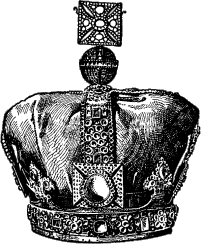

 probably correctly represents the case when he states: "From the reign of Edward III. coronets of various forms were worn (as it seems indiscriminately) by princes, dukes, earls, and even knights, but apparently rather by way of ornament than distinction, or if for distinction, only (like the collar of SS) as a mark of gentility. The helmet of Edward the Black Prince, upon his effigy at Canterbury, is surrounded with a coronet totally different from that subsequently assigned to his rank."
probably correctly represents the case when he states: "From the reign of Edward III. coronets of various forms were worn (as it seems indiscriminately) by princes, dukes, earls, and even knights, but apparently rather by way of ornament than distinction, or if for distinction, only (like the collar of SS) as a mark of gentility. The helmet of Edward the Black Prince, upon his effigy at Canterbury, is surrounded with a coronet totally different from that subsequently assigned to his rank." |
| FIG. 656.--Ducal coronet. |
*1 Out of a ducal coronet gules, a lion's head ermine (Nicholson).Probably, however, the most curious instance of all will be found in the case of a crest coronet of ermine, of which an example occurs in the Gelre "Armorial."


*1 Crest of Bentinck: Out of a marquess's coronet proper, two arms counter-embowed, vested gules, on the hands gloves or, and in each hand an ostrich feather argent.There are some number of instances of the use of an earl's coronet as a crest coronet. Amongst these may be mentioned the crests of Sir Alan Seton Steuart, Bart. ["Out of an earl's coronet a dexter hand grasping a thistle all proper"], that granted to Cassan of Sheffield House, Ireland [" Issuant from an earl's coronet proper, a boar's head and neck erased or, langued gules"], James Christopher Fitzgerald Kenney, Esq., Dublin [" Out of an earl's coronet or, the pearls argent, a cubit arm erect vested gules, cuffed also argent, the hand grasping a roll of parchment proper"], and Davidson ["Out of an earl's coronet or, a dove rising argent, holding in the beak a wheat-stalk bladed and eared all proper "].
 |
| FIG. 657.--Mural Coronet. |
 |
| FIG. 658.--Naval crown. |
 |
| FIG. 659.--Eastern crown. |
 |
| FIG. 660.--Crown vallary. |
 |
| FIG. 661.--Palisado crown. |
 |
| FIG. 662.--The Crown of King Charles II. |
 |
| FIG. 663.--The Chapeau. |